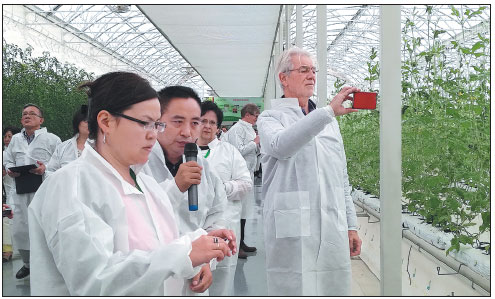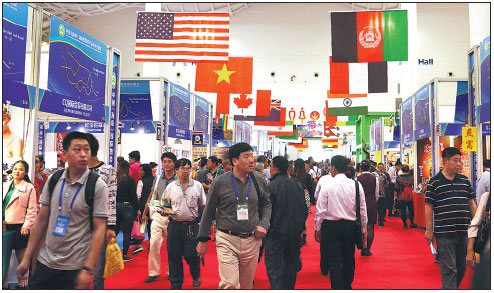The GDP of Hainan, China's southernmost province, grew by 7.5 percent year-on-year to 404.45 billion yuan ($58.85 billion) in 2016, data released by the provincial government show. The growth came as the island underwent an industrial upgrading boom to develop its pillar industries.
Many opportunities were brought about by the country's ongoing supply-side reforms, booming outbound tourism market, intensified business and people-to-people exchanges generated by new growth momentum.
The supply-side reforms include a series of policies to improve the manufacturing and agricultural sectors, public services, environmental protection, the quality and scale of production, and the further opening-up of Chinese markets to foreign investors.
Liu Cigui, governor of Hainan, said the island province is a vital pillar for trade, investment and services activities for countries and regions along the Belt and Road Initiative.
The Silk Road Economic Belt and the 21st Century Maritime Silk Road, comprising an envisioned infrastructure, trade and service network proposed by the Chinese government in 2013, will cover about 4.4 billion people in more than 60 countries and regions across Europe, Asia and Africa.
Official data show that the service sector's contribution to the province's GDP grew 10.1 percent year-on-year to 217.9 billion yuan in 2016.
Hainan also received $2.22 billion in foreign direct investment and signed 88 big-ticket contracts with partners from various countries and regions.
The provincial government has conducted feasibility studies on developing a free trade zone with the members of the Association of Southeast Asian Nations.
He Dongni, vice-president of the Haikou-based China Institute of Reform and Development, said major infrastructure projects offer significant growth potential in China's urbanization progress, both for domestic and global companies, especially in Hainan's lower-tier cities and in particular in the current global business climate.
Attracting investment
Dalian Wanda Group invested 50 billion yuan in Haikou, the provincial capital, to build a new urban area with multiple services functions in 2016. This follows a 7 billion yuan investment in 2015 to build a commercial building block.
Chinese e-commerce giant Alibaba Group set up its entertainment business headquarters for southern China in Haikou. It also developed a big data system to further integrate internet technologies and the upgrade of its tourism business, as well as establishing other e-commerce businesses in Hainan's rural areas.
In terms of developing retail businesses, Sun Ying, director-general of Hainan Provincial Tourism Development Commission, said duty-free shopping has become a driving factor that draws domestic and foreign visitors to Hainan.
Authorized by the central government in 2011, Hainan offers a duty-free allowance to non-locals of 16,000 yuan a year.
The province aims to attract more than 80 million tourists annually by 2020, including 1.2 million from overseas. The provincial government estimates that total annual tourism revenue will surpass 100 billion yuan by the same year.
"We will further upgrade the infrastructure and service levels of the aviation, tourism, hotels, cruisers and duty free sectors of Hainan to that of a top international resort," said Sun.
Separately, sea tours along the eastern fringe of the province and forest-themed trips are being developed. Campsites for self-drive tourists are being created too. A total of 100 towns and 1,000 villages will be developed before 2020 to enrich visitor experiences on the island.
As for transportation, the government is undertaking various projects to improve the island's air links. The province added 30 outbound flight routes last year, taking the total number to 51.
The number of inbound tourists for 2016 amounted to 748,900, up 23.9 percent over the previous year. The province expects that the number of visitors and revenue generated from the tourism sector could reach 60.24 million visits and 66.92 billion yuan, up 12.87 percent and 16.97 percent, respectively, this year.
Rises across all sectors
The development of the Belt and Road Initiative has also created a wider market for Hainan's modern agriculture sector. The province is deploying more financial resources and manpower in modern fishery, livestock and sea farming, and food processing.
It expects that the number of newly registered internet-related companies and their combined operating revenue will reach 2,200 and 32 billion yuan respectively by the end of this year. Both government departments and private companies, such as the National Development and Reform Commission, State Information Center and Tencent, all chose to establish big data centers in the province.
Hainan aims to become a world-class medical tourism destination within five years by developing the Boao Lecheng International Medical Tourism Pilot Zone. The zone benefits from nine preferential policies, including special permissions for medical professionals, technology, devices and drugs, and an allowance for the entry of foreign capital and international communications.
The province's investment into the pilot zone will total 19.8 billion yuan, of which 1.7 billion yuan has been invested so far, involving building cooperative relationships with various healthcare organizations and institutions from around the world.
Hainan has committed to deepening its implementation of supply-side reforms and to allocating more financial resources to the endeavor.

Foreign experts visit a fruit farm with intellectualized management in Hainan's Lingshui county.Ma Zhiping / China Daily

Delegates from more than 50 countries attend the 2016 China (Hainan) International Tropical Agricultural Products Winter Trade Fair held in December.Weng Xiaowen / China Daily